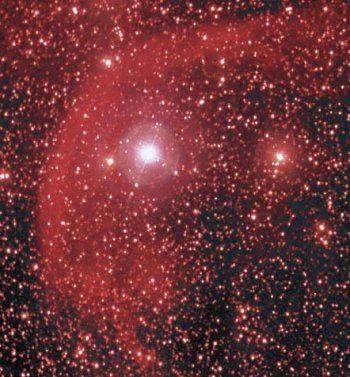Magnitude 4.29 Apparent magnitude (V) 4.29 | Constellation Camelopardalis | |
 | ||
Similar Beta Camelopardalis, NGC 1502, Eta Draconis, HD 104985 | ||
Alpha Camelopardalis (Alpha Cam, α Camelopardalis, α Cam) is a star in the constellation Camelopardalis, with an apparent visual magnitude of 4.3. It is the third-brightest star in this not-very-prominent circumpolar constellation, the first and second-brightest stars being β Camelopardalis and CS Camelopardalis, respectively. It is the farthest constellational star, with a distance of 6,000 light-years from Earth.
This star has a stellar classification of O9 Ia, with the 'Ia' indicating that it is an O-type luminous supergiant. It is a massive star with 31 times the mass of the Sun and 37 times the Sun's radius. The effective temperature of the outer envelope is 30,000 K; much hotter than the Sun's effective temperature of 5,778 K, giving it the characteristic blue hue of an O-type star. It is emitting 620,000 times the luminosity of the Sun and is a weak X-ray emitter.
This star shows multiple patterns of variability. It may be a non-radial pulsating variable star, which is causing changes in the spectrum being emitted by the photosphere. The absorption lines in the optical spectrum show radial velocity variations, although there is significant uncertainty about the period. Estimates range from a period as low as 0.36 days up to 2.93 days. The stellar wind from this star is not smooth and continuous, but instead shows a behavior indicating clumping at both large and small scales. This star is losing mass rapidly through its stellar wind at a rate of approximately 6.3 × 10−6 solar masses per year, or the equivalent of the mass of the Sun every 160,000 years.
In 1968, this star was classified as a spectroscopic binary, indicating that it has an orbiting stellar companion with a period of 3.68 days and an orbital eccentricity of 0.45. Subsequent studies refined the period to 3.24 days. However, in 2006 it was recognized that the changes in the spectrum were probably the result of changes in the atmosphere or stellar wind, so it is more likely a single star. Speckle interferometry observations with the 3.67 m Advanced Electro Optical System Telescope at the Haleakala Observatory failed to detect a secondary component.
In 1961, based on the criteria that the proper motion of this star indicates a space velocity of greater than 30 km/s, Alpha Camelopardalis was suggested as a candidate runaway star that had been ejected from the cluster NGC 1502. This was based upon the kinematic properties of the star and cluster, as well as the location of this star at a high galactic latitude in an area otherwise lacking in stellar associations. Over the course of a million years, this star should have moved only 1.4° across the sky, while it was estimated as being only two million years old.
Runaway stars such as this with a stellar wind that is moving at supersonic velocity through the interstellar medium have their wind confined by a bow shock due to ram pressure. The dust in this bow shock can be detected using an infrared telescope. Just such a bow shock was observed with NASA's Wide-field Infrared Survey Explorer, or WISE. The star is traveling at a rate of somewhere between 680 and 4,200 kilometers per second: between 1.5 and 9.4 million mph.
Chinese name
In Chinese, 紫微右垣 (Zǐ Wēi Yòu Yuán), meaning Right Wall of Purple Forbidden Enclosure, refers to an asterism consisting of α Camelopardalis, α Draconis, κ Draconis, λ Draconis, 24 Ursae Majoris, 43 Camelopardalis and BK Camelopardalis. Consequently, α Camelopardalis itself is known as 紫微右垣六 (Zǐ Wēi Yòu Yuán liù, English: the Sixth Star of Right Wall of Purple Forbidden Enclosure.), representing 少衛 (Shǎowèi), meaning Second Imperial Guard. 少衛 (Shǎowèi) is westernized into Shaou Wei by R. H. Allen, the meaning is "Minor Guard", but it is not clearly designated.
